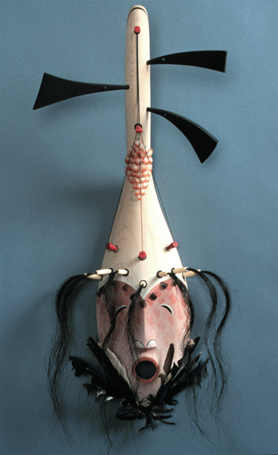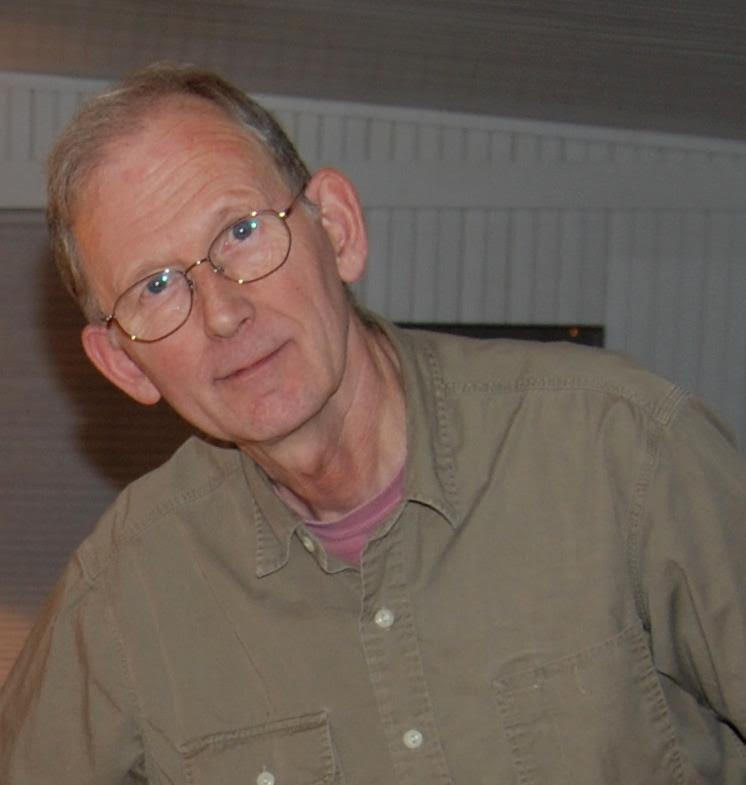
“Instrument of Change” by Jim Schoppert
Reinventing Tradition:
Innovation and Renewal in the Art of Jim Schoppert
by RAY HUDSON
When Jim Schoppert, a twenty five year old carpenter, found himself in Anchorage, Alaska for a job that didn’t materialize, he decided to go into a hobby shop and use his last fifteen dollars to purchase a piece of soapstone. He began to carve, and encouraged by his sister, he sold one of the two resulting owls. He never looked back. Over the course of the next two decades, he created a body of work that would make significant contributions to our understanding of “tradition,” “innovation,” and “renewal” in the art of the Native peoples of the Northwest Coast.
Born in Juneau, Alaska, on May 28, 1947, Schoppert grew up in nearby Douglas. On his mother’s side, he was the grandson of Tlingit Taku chief Jimmy Fox while his father was of German ancestry. Schoppert’s eyes were described by a friend as “winter dark” and “full of mystery.” In a tribute to Schoppert that appeared in the Alaska Bahá’í News, John Walker wrote of Schoppert: “[His] jet black hair, often worn long, made me think he must be akin to the Raven.” In fact, Schoppert was a member of the Raven moiety and the Kiks.ádi clan. He never mentioned “his history of hard knocks and heartaches,” according to Walker, but laughed and challenged conventions and rode out his life far too quickly, dying in 1992 at the age of 45.
In 1997, the Anchorage Museum of History and Art mounted a posthumous retrospective, which traveled to several major cities, including New York. While there, Schoppert’s work caught the attention of New York Times art critic Holland Cotter who wrote of Schoppert’s art that it was “clearly in the business of bridging sophisticated cultures, namely European modernism and traditional Northwest Indian art.” Cotter was most impressed with the several monumental polychrome wall sculptures carved from wood:
The deeply cut designs and twilight colors . . . are adapted from traditional images and still suggest naturalistic features: a bird’s beak and eye, for example. But here forms that were already highly schematic have been further abstracted and rearranged, preserved but also turned into something new.” 1
Although carved and painted panels as well as masks are among his best known and most admired work, Schoppert’s art encompasses a wide range of styles and media, from wood and soapstone carving to painting and print making. Moreover, it demonstrates a remarkable range of artistic versatility rooted in what Schoppert describes as a preoccupation with understanding what the Native art of Alaska lost after contact with the European settlers — an uninterrupted evolution of its art forms — and what it might now gain if traditional art forms were revisited and reimagined.
In “Miro and the Midnight Sun,” for example, Schoppert experiments with techniques pioneered by influential twentieth century painter Joan Miro to render the Alaskan landscape as it appears when illuminated by the midnight sun. “My thinking,” Schoppert has remarked when speaking of the contemporary arts of the Tlingit people “is that all of the artform . . . comes from that very strong mystical relationship with the land.”
2
Impossible as it is to describe visual art in prose, articulating seminal influences on an artist can be equally doomed. Nevertheless, Schoppert attempted to do this on occasion. Speaking about the development of new “Native art forms” he once said:
It is a spiritual reawakening, not political or economic. It’s purely intuitive rebirth. The young people are burning with interest to learn songs, dances and art forms. In an expanded sense of world unity, this art form that once belonged to the Tlingit people now belongs to the entire world, toward oneness.3
In 1974, less than a year after joining the Bahá’í Faith, he presented the mask “Snowy Owl” to the Bahá’í International Community, an NGO at the United Nations. Schoppert never let go of his art. Over the years, he produced a remarkable and very distinctive body of work, which can now be found in numerous private and public collections and continues to serve as an inspiration to viewers, as in the case of “Another Feather for Moon’s Nest,” a carved and painted panel that was used by the National Museum of the American Indian for the cover of its publication following the tragedies of September 11, 2001. “Great works of art elicit the power of hope and inspiration,” wrote the editor, “while others move us to reflect.”
Schoppert’s work can be found at https://en.wikipedia.org/wiki/James_Schoppert and at https://discover.stqry.com/v/modern-mask-james-schoppert/s/741beba13a3557a4da072432dc6d8d2f
Footnotes:
1 - Cotter, Holland. “Art in Review.” New York Times. Dec. 3, 1999.
2 - Steinbright, Jan. “Interview: Jim Schoppert” in Journal of Alaska Native Art, March-April 1987.
3 - Carroll, Patricia. “Jim Schoppert: Minimal Sculptor,” The Alaska Journal. Spring 1979:91.

Bio: Ray Hudson’s memoir of living in the Aleutian Islands, Moments Rightly Placed, was listed among the 10 best books on Alaska in a recent article in The Guardian. It was selected as one of Alaska’s best history books by the Alaska Historical Society. He is the author and editor of several scholarly books on the Aleutian Islands. A retired public school teacher, he is a woodblock artist and poet who lives in Vermont.